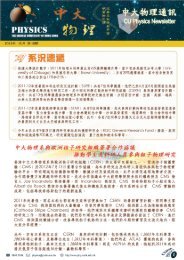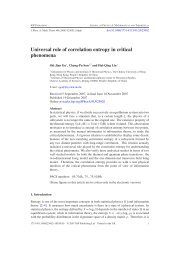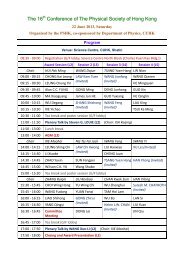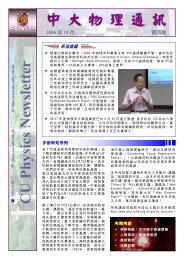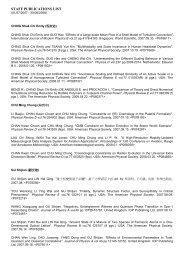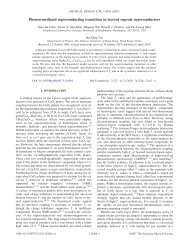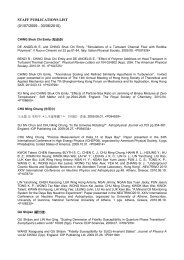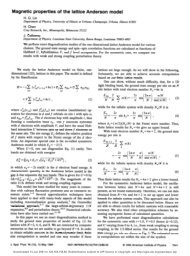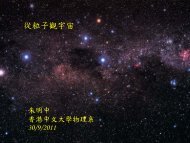Dark Energy Survey - Department of Physics - The Chinese ...
Dark Energy Survey - Department of Physics - The Chinese ...
Dark Energy Survey - Department of Physics - The Chinese ...
Create successful ePaper yourself
Turn your PDF publications into a flip-book with our unique Google optimized e-Paper software.
Design <strong>of</strong> Emulator for Testing the Image Acquisition from the<br />
520 Megapixel CCD Camera in <strong>Dark</strong> <strong>Energy</strong> <strong>Survey</strong><br />
Cheuk-yui Leung<br />
2 nd September 2006<br />
1) Introduction<br />
In the project dark <strong>Energy</strong> survey, a 520 megapixel Charged-Coupled device (CCD)<br />
camera will be built at Cerro Tololo Inter-American Observatory. University <strong>of</strong> Illinois<br />
designs and builds the data acquisition system while Lawrence Berkeley National<br />
laboratory (LBNL) designs CCDs. <strong>The</strong> image acquisition system is to be tested and<br />
debugged before LBML CCDs are ready. Hence, Circuit boards with field<br />
programmable gate array (FPGA) called emulators are designed to emulate CCDs.<br />
2) Background<br />
2.1) Data transferring mode from CCDs<br />
Fig.1 shows a CCD schematically. Each CCD consists <strong>of</strong> 2048 x 4096 pixels. <strong>The</strong>re is<br />
one line <strong>of</strong> horizontal shift register at the bottom <strong>of</strong> the CCD board. <strong>The</strong> CCD is divided<br />
into two parts. <strong>The</strong> right half named ‘lower’ and the left named ‘higher’. <strong>The</strong>re are<br />
output gates at the bottom right (lower output) and left (upper output) <strong>of</strong> the CCD<br />
alternatively.<br />
When the pulses representing the vertical shift command are sent to the CCD board, the<br />
pulse signals will be checked. <strong>The</strong> correct sequence <strong>of</strong> pulse is show in Fig.2. If the<br />
signals are correct, the memory stored in the lowest row <strong>of</strong> pixels will be shifted to the<br />
horizontal shift register. Memory stored in the second lowest row will be shifted to the<br />
lowest row, etc.<br />
When the pulses representing the horizontal shift command are sent to the ‘upper’<br />
horizontal input <strong>of</strong> CCD board, the pulse signals will be checked. <strong>The</strong> correct sequence<br />
<strong>of</strong> pulse is shown in Fig.3. If the signals are correct, the most left memory bit <strong>of</strong> the<br />
horizontal shift register in ‘upper’ will be shifted to the detector on the left. <strong>The</strong><br />
information <strong>of</strong> that memory will then be transmitted away. <strong>The</strong> second most left<br />
memory will shift left, etc. ‘Lower’ also works in the same way except the memories in<br />
the shift register are shifted right.<br />
Vertical signals and horizontal signals are inputted alternatively until all information<br />
stored in the CCD is transmitted away.
3) Programming <strong>of</strong> FPGA<br />
3.1) Some facts about the emulator<br />
Altera Cyclone II chips are used in the circuit for the emulator and the s<strong>of</strong>tware Quantus<br />
II is used to program the chips. Each chip contains 64 x 64 points <strong>of</strong> memory. By<br />
repeating it over and over, we can emulate the whole 2048 x 4096 pixels CCD. That<br />
means if we program the database <strong>of</strong> emulator like the star in Fig 15, we expect to<br />
emulate the CCD like Fig 16, with Fig 15 repeat over and over.<br />
Hence, the address <strong>of</strong> each emulated pixel is assigned with 12 bits, while the first 6 bits<br />
represent the row number and the last 6 bits represent the column number. 8 bits <strong>of</strong><br />
memory are assigned to each pixel.<br />
<strong>The</strong> program is mainly divided into input <strong>of</strong> pulse, checking <strong>of</strong> pulse and output <strong>of</strong> data.<br />
<strong>The</strong> outlook is shown in Fig 4, 5 and 6 respectively.<br />
<strong>The</strong> vertical shift checking system is clocked with period <strong>of</strong> 100.0ns. Both the upper<br />
and lower horizontal shift checking systems are clocked with period <strong>of</strong> 10.0ns.<br />
3.2) <strong>The</strong> idea <strong>of</strong> checking pulse<br />
When the pulses representing a vertical shift or horizontal shift are being input, the<br />
signal is checked.<br />
<strong>The</strong>re are 5 inputs <strong>of</strong> pulses for the vertical shift, which are TG, V1, V2, V3, TRIGOUT<br />
respectively. <strong>The</strong>re are also 5 inputs for the Horizontal inputs respectively, which are RG,<br />
H1, H2, H3, SW respectively. Please refer to Fig 2 and 3 for the correct sequence <strong>of</strong><br />
input pulses.<br />
<strong>The</strong> pulses are checked at the edges where their signals are changed. Take the V1 input<br />
<strong>of</strong> the vertical shift input as example. <strong>The</strong> signal changes at 60.4us and 121.2us. To<br />
ensure the input signal change at 60.4us, we use an AND gate to check if the signal at<br />
58.0us (signal = 1) and the inverse <strong>of</strong> signal at 62.0us (the signal = 0, the inverse should<br />
be 1) are the same. All other edges <strong>of</strong> pulses are checked in the same way. If the signals<br />
in V1, Y2, V3, TRIGOUT are correct, the signal <strong>of</strong> the output GOOD VERTICAL will<br />
be changed from 0 into 1 until the next set <strong>of</strong> pulses are being input.<br />
<strong>The</strong> same procedure also applies to the checking system <strong>of</strong> upper and lower horizontal<br />
shift. <strong>The</strong> only difference is that the names <strong>of</strong> the output are GOOD UPPER<br />
HORIZONTAL and GOOD LOWER HORIZONTAL. And the outputs will become<br />
high only for 20 ns. At this 20ns, data will be read from the database and will become
the output. A state machine is used to control the checking <strong>of</strong> signals.<br />
3.3) Output <strong>of</strong> the program<br />
Please refer to Fig 6 for the program interface specifying the output. <strong>The</strong>re are address<br />
counters outputting the vertical (lpm_counter2), upper horizontal and lower horizontal<br />
(lpm_counter1) address <strong>of</strong> the data respectively. When checking is performed, the<br />
address counter would automatically increase the address output by 1 no matter the<br />
pulses are checked to be good or not. <strong>The</strong> address is then sent to the database<br />
(lpm_rom0 and lpm_rom1). Corresponding data are then sent to another logic element<br />
called MUX. <strong>The</strong> outputs <strong>of</strong> GOOD VERTICAL, GOOD UPPER HORIZONTAL and<br />
GOOD LOWER HORIZONTAL are also sent to MUX. If the input pulses passed all the<br />
checks, the corresponding data will then be the output <strong>of</strong> MUX. Otherwise, another<br />
assigned number will be sent out. <strong>The</strong> assigned number is 171 for the upper system and<br />
205 for the lower system. Hence, we would know the input is incorrect if these two<br />
numbers are generated.<br />
3.4) Pin assignment<br />
Since the pins on the circuit board are fixed, it is necessary to ensure that the inputs and<br />
outputs are assigned to fixed pins on the chip. Hence, the circuit board still can function<br />
well even the program inside the FPGA is changed. <strong>The</strong> pin assignment table is shown<br />
in Fig 7.<br />
4) Testing <strong>of</strong> the program<br />
<strong>The</strong> first few columns and rows <strong>of</strong> the emulated database are shown in table 1.<br />
Table 1: A part <strong>of</strong> the emulated database<br />
Address 0 1 2 3<br />
0 0 1 2 3<br />
1 64 65 66 67<br />
<strong>The</strong> initial value <strong>of</strong> the horizontal address and vertical address are both 64. Hence, the<br />
values <strong>of</strong> them will be 0 after the first checking <strong>of</strong> vertical and horizontal input signals.<br />
And the first data output will be the one with position (0,0).<br />
In Fig 8, RGU, H1U, H2U, H3U, SWU represent the upper horizontal shift input signals.<br />
RGL, H1L, H2L, H3L, SWL represent the lower horizontal shift input signals. TG, V1,<br />
V2, V3 represent the vertical shift input signal. OUTL [0]-[7] represent the outputs <strong>of</strong><br />
the lower system and OUTU [0]-[7] represent the outputs <strong>of</strong> the upper system.<br />
<strong>The</strong> output <strong>of</strong> upper system and lower system will only be transferred when clk_dac_u
and clk_dac_l are high respectively. <strong>The</strong> period is 20ns as stated before.<br />
4.1) Testing <strong>of</strong> vertical shift input signal<br />
4.1.1) <strong>The</strong> result <strong>of</strong> correct input signals<br />
In Fig 9, a set <strong>of</strong> correct vertical shift pulses was inputted. When there are correct<br />
horizontal shift pulses come later, the system gives out data from the database.<br />
4.1.2) <strong>The</strong> result <strong>of</strong> incorrect signals<br />
In Fig 10, a set <strong>of</strong> incorrect vertical shift pulses was inputted. <strong>The</strong> system does not give<br />
out data from the database even there are correct horizontal shift pulses inputted.<br />
4.2) Testing <strong>of</strong> horizontal shift input signal<br />
In this case, the system is checked with the first row <strong>of</strong> data in table 1. That means right<br />
after the first set <strong>of</strong> vertical input signal is being inputted.<br />
4.2.1) <strong>The</strong> result <strong>of</strong> correct input signals<br />
Three sets <strong>of</strong> correct signals are input in sequence. In Fig 11, 12 and 13, the correct<br />
outputs 00000000, 00000001, 00000010 are given out respectively.<br />
4.2.2) <strong>The</strong> result <strong>of</strong> incorrect signals<br />
In Fig 14, the H1U input <strong>of</strong> the second group pulses is incorrect. Hence, the output<br />
would remain at the value 171 when clk_dac_u is high. This number indicates that the<br />
input pulses are not correct.<br />
5) Conclusion and future development<br />
<strong>The</strong> project dark energy survey is aimed at investigating the dark energy in the universe.<br />
A 520 megapixel Charged-Coupled device (CCD) camera telescope will be built for this<br />
purpose. UIUC is to build the data acquisition system <strong>of</strong> the telescope. <strong>The</strong> emulator is<br />
designed to simulate the CCD output for testing.<br />
This report mainly concerns the programming <strong>of</strong> Altera Cyclone II chips.<br />
In the future, printed circuit board containing Altera Cyclone II chips will be designed.<br />
And these emulators will be used to test the data acquisition system.<br />
6) Acknowledgement<br />
I would like to thank pr<strong>of</strong>essor John Thaler and pr<strong>of</strong>essor Mats Selen <strong>of</strong> University <strong>of</strong><br />
Illinois at Urbana-Champaign for letting me to join their research group and work under<br />
their guidance.
I would also like to thank the physics department <strong>of</strong> <strong>The</strong> <strong>Chinese</strong> university <strong>of</strong> Hong<br />
Kong for giving me a chance to UIUC for a summer exchange.<br />
7) References<br />
- E.L. Dagless, J.O. Reilly; Electronics: A System Approach; Addison- Wesley<br />
Publishing Company; 1992<br />
- Proposal to NOAO for the dark energy <strong>Survey</strong>. Retrieved 12/6/2006 from<br />
http://cosmology.uiuc.edu/DES/Documents/A_Proposal_to_NOAO.pdf
Appendix:<br />
Fig.1 A CCD <strong>of</strong> the camera<br />
Fig 2. Correct sequence <strong>of</strong> input pulses for a vertical shift commend<br />
Fig 3. Correct sequence <strong>of</strong> input pulses for a horizontal shift commend
Fig. 4 Interface <strong>of</strong> program for input <strong>of</strong> pulses<br />
Fig. 5 Interface <strong>of</strong> program for checking <strong>of</strong> pulses
Fig. 6 Interface <strong>of</strong> program for output <strong>of</strong> Data<br />
Fig. 7 Location <strong>of</strong> the chip pins assigned to the inputs and outputs
Fig. 8 Inputs and output names during the simulation <strong>of</strong> program<br />
Fig. 9 Output with correct input <strong>of</strong> vertical shift signals. <strong>The</strong> red square contains the<br />
input <strong>of</strong> vertical shift signals. <strong>The</strong> blue square contains the output.
Fig. 10 Output with incorrect input <strong>of</strong> vertical shift signals. <strong>The</strong> red square contains the<br />
input <strong>of</strong> vertical shift signals. <strong>The</strong> green square contains the input <strong>of</strong> horizontal shift<br />
pulses. <strong>The</strong> blue square contains the output.<br />
Fig.11 Output after the first input <strong>of</strong> correct horizontal shift signals. <strong>The</strong> red square<br />
contains the output <strong>of</strong> the upper system. <strong>The</strong> blue square contains the output <strong>of</strong> lower<br />
system
Fig.12 Output after the second input <strong>of</strong> correct horizontal shift signals. <strong>The</strong> red square<br />
contains the output <strong>of</strong> the upper system. <strong>The</strong> blue square contains the output <strong>of</strong> lower<br />
system<br />
Fig.13 Output after the third input <strong>of</strong> correct horizontal shift signals. <strong>The</strong> red square<br />
contains the output <strong>of</strong> the upper system. <strong>The</strong> blue square contains the output <strong>of</strong> lower<br />
system
Fig.14 Output after the input <strong>of</strong> correct and incorrect horizontal shift signals. <strong>The</strong> red<br />
square contains the input and output with correct input pulses. <strong>The</strong> blue square contains<br />
the input and output with incorrect input pulses. <strong>The</strong> green squares indicate where the<br />
input signals are incorrect.<br />
Fig.15 <strong>The</strong> database <strong>of</strong> the emulator programmed with the information <strong>of</strong> a star<br />
Fig.16 <strong>The</strong> expected outlook <strong>of</strong> the CCD emulated with information in Fig. 16



